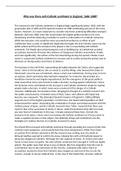Why was there anti-Catholic sentiment in England, 1660-1688?
The reasons for anti-Catholic sentiment in England begin significantly before 1660, with the
gunpowder plot of 1605 and the Spanish invasion of 1588 constituting just two of the many
factors. However, it is more important to consider why these underlying difficulties emerged
between 1660 and 1688, since this would shake the English political system to its core,
threatening and then delivering revolution to avoid a continuation of a Catholic monarchy.
While the exclusion crisis would be more accurately described as an effect of anti-
Catholicism than a cause, its significant implications brought the anti-Catholic cause into the
public sphere and thus the exclusion crisis played a role in resuscitating anti-Catholic
sentiment. The Popish plot certainly played a role in building fear of Catholicism as Oates’
accusations seemed to threaten the existence of dangerous Catholics everywhere. Finally,
and most significantly, the actions of the two Stuart Kings during the period, Charles II and
James II, caused anti-Catholic sentiment to increase and to surface during the period, due to
decisions on foreign policy and choice of advisors.
The Exclusion Crisis (1679-81), representing the battle between the Tories, who supported
James’ claim to his hereditary role as monarch, and the Whigs, who favoured the Duke of
Monmouth, since he was a Protestant, shows a clash over Catholicism, forcing many to form
an opinion, where previously they had been impartial. For centuries, the principle of a
hereditary monarchy was largely unquestioned, but the emergence of this great political
clash meant that many were forced to make a decision, turning against Catholicism. Hence,
the Exclusion Crisis contributed to the increase in anti-Catholic sentiment simply by making
people make a decision, in which many were convinced of the danger of a Catholic
monarch. Additionally, the Exclusion Crisis, bringing the thought of a Catholic monarch into
the public consciousness, reminded many of Mary Tudor, who alliance with Spain had
become very unpopular. The attempted Spanish invasion of England in 1588 justifiably
angered much of the English population. Furthermore, the failed Cadiz Expedition of 1625
embarrassed the nation. Associating this combination of anger and embarrassment with the
Catholic power of Spain, and the Catholic monarch Mary Tudor, many felt that there was
much to fear in the succession of James II. Hence, while the Exclusion Crisis did not create
any new fears of Catholicism in this way, it simply extracted these fears. Overall, the
Exclusion Crisis plays a minor role in increasing anti-Catholic sentiment as it forces some to
make a negative decision on the subject, but definitely brings anti-Catholicism into the
limelight as it realises the fear of a Catholic monarch for many.
The Popish Plot increased anti-Catholic sentiment through spreading the concern firstly that
Catholics were dangerous, and secondly that they were omnipresent. While Titus Oates’
accusation that Catholics planned to kill the monarch was nothing new, the death of
Edmund Godfrey seemed to confirm his views, imbuing him with a McCarthyist power to
denounce dangerous Catholics. Although the vast majority of Oates’ 35 victims were later
found to have been not-guilty, the anti-Catholic sentiment that emerged in 1678 was highly
potent. The public news that James II was a Catholic after his resignation from the role of
Lord Admiral, due to the restrictions of the Test Act, combined with Oates’ flurry of
accusations seemed to show that Catholics were dangerous and next-in-line to rule the
country, enough to arouse national fear. In the case of the Popish Plot, previous national




